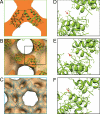Structure and assembly of immature HIV
- PMID: 19549863
- PMCID: PMC2700151
- DOI: 10.1073/pnas.0903535106
Structure and assembly of immature HIV
Abstract
The major structural components of HIV are synthesized as a 55-kDa polyprotein, Gag. Particle formation is driven by the self-assembly of Gag into a curved hexameric lattice, the structure of which is poorly understood. We used cryoelectron tomography and contrast-transfer-function corrected subtomogram averaging to study the structure of the assembled immature Gag lattice to approximately 17-A resolution. Gag is arranged in the immature virus as a single, continuous, but incomplete hexameric lattice whose curvature is mediated without a requirement for pentameric defects. The resolution of the structure allows positioning of individual protein domains. High-resolution crystal structures were fitted into the reconstruction to locate protein-protein interfaces involved in Gag assembly, and to identify the structural transformations associated with virus maturation. The results of this study suggest a concept for the formation of nonsymmetrical enveloped viruses of variable sizes.
Conflict of interest statement
The authors declare no conflict of interest.
Figures







References
-
- Demirov DG, Freed EO. Retrovirus budding. Virus Res. 2004;106:87–102. - PubMed
-
- Morita E, Sundquist WI. Retrovirus budding. Annu Rev Cell Dev Biol. 2004;20:395–425. - PubMed
-
- Briggs JAG, Johnson MC, Simon MN, Fuller SD, Vogt VM. Cryo-electron microscopy reveals conserved and divergent features of Gag packing in immature particles of Rous Sarcoma virus and human immunodeficiency virus. J Mol Biol. 2006;355:157–168. - PubMed
-
- Adamson CS, Freed EO. Human immunodeficiency virus type 1 assembly, release, and maturation. Adv Pharmacol. 2007;55:347–387. - PubMed
Publication types
MeSH terms
Substances
LinkOut - more resources
Full Text Sources
Other Literature Sources
Molecular Biology Databases

